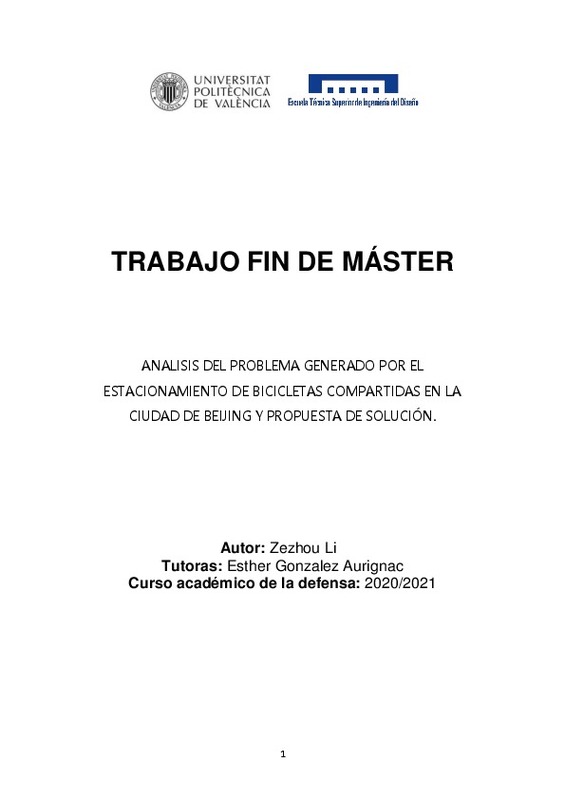JavaScript is disabled for your browser. Some features of this site may not work without it.
Buscar en RiuNet
Listar
Mi cuenta
Estadísticas
Ayuda RiuNet
Admin. UPV
Análisis del problema generado por el estacionamiento de bicicletas en la ciudad de Beijing y propuesta de solución
Mostrar el registro sencillo del ítem
Ficheros en el ítem
| dc.contributor.advisor | González Aurignac, Esther
|
es_ES |
| dc.contributor.author | Li, Zezhou
|
es_ES |
| dc.coverage.spatial | east=116.4073963; north=39.90419989999999; name=Zheng Yi Lu, Dongcheng Qu, Beijing Shi, Xina | es_ES |
| dc.date.accessioned | 2021-05-17T07:37:29Z | |
| dc.date.available | 2021-05-17T07:37:29Z | |
| dc.date.created | 2021-04-29 | |
| dc.date.issued | 2021-05-17 | es_ES |
| dc.identifier.uri | http://hdl.handle.net/10251/166420 | |
| dc.description.abstract | [ES] En este trabajo, he estudiado los diversos problemas que se han producido con las bicicletas compartidas actuales de Beijing y he propuesto las soluciones correspondientes a estos problemas. Primeramente, creamos un cuestionario para recopilar las opiniones y sugerencias de los usuarios de bicicletas compartidas sobre toda la industria de bicicletas compartidas y las instalaciones de apoyo para este nuevo modo de movilidad urbana. Para ello, seleccionamos al azar a 67 personas para realizar una encuesta, el propósito fue comprender sus puntos de vista sobre las bicicletas compartidas como usuarios y como espectadores, y sus demandas de transporte compartido. Luego entrevistamos al oficial Luo, jefe de la Brigada de trafico. Comparamos los resultados de la entrevista con los resultados de 67 cuestionarios y encontramos un fenómeno interesante, es decir, el 86,57% de los usuarios creían que nunca habían aparcado una bicicleta compartida de forma ilegal. Sin embargo, la policía cree que la mayoría de la gente estaciona indiscriminadamente, o incluso estaciona en el pavimento táctil, lo que dificulta el desplazamiento de las personas ciegas y trae molestias a muchos viandantes. Después de analizar el cuestionario, encontramos que la gran mayoría de los usuarios estacionaron bicicletas compartidas en ubicaciones inapropiadas, y es fácil hacer que las bicicletas se amontonen, sin embargo nofueron conscientes de que la ubicación de su estacionamiento era inapropiada. En respuesta a este problema, hicimos tres propuestas para diseñar nuevos espacios de estacionamiento de bicicletas. La importancia radica en resolver el problema de que las bicicletas compartidas se amontonan y estacionan en centros de transporte, cerca de estaciones de autobuses, grandes centros comerciales y otros lugares, lo que interrumpe los viajes de otros. El problema de las bicicletas compartidas es un problema muy grave, porque interfiere con el desplazamiento de los demás habitantes , con el aspecto de la ciudad y es causa de un grave desperdicio de recursos. | es_ES |
| dc.description.abstract | [EN] In this paper, I have studied the various problems that have occurred with Beijing's current bicycle sharing and proposed corresponding solutions to these problems. First, we created a questionnaire to collect the opinions and suggestions of bike-sharing users on the whole bike-sharing industry and the supporting facilities for this new mode of urban mobility. To do this, we randomly selected 67 people to conduct a survey, the purpose of which was to understand their views on bikesharing as users and bystanders, and their demands for shared transport. We then interviewed Officer Luo, head of the Traffic Squad. We compared the results of the interview with the results of 67 questionnaires and found an interesting phenomenon, i.e. 86.57% of the users believed that they had never parked a shared bicycle illegally. However, the police believe that most people park indiscriminately, or even park on the tactile pavement, which makes it difficult for blind people to move around and brings inconvenience to many passers-by. After analysing the questionnaire, we found that the vast majority of users parked shared bicycles in inappropriate locations, and it is easy to make bicycles pile up, yet they were not aware that their parking location was inappropriate. In response to this problem, we made three proposals to design new bicycle parking spaces. The importance lies in solving the problem of shared bicycles piling up and parking in transport hubs, near bus stations, large shopping centres and other locations, which disrupts the journeys of others. The problem of shared bicycles is a very serious problem, because it interferes with the movement of other inhabitants, with the appearance of the city and is a serious waste of resources. | es_ES |
| dc.format.extent | 64 | es_ES |
| dc.language | Español | es_ES |
| dc.publisher | Universitat Politècnica de València | es_ES |
| dc.rights | Reserva de todos los derechos | es_ES |
| dc.subject | Beijing | es_ES |
| dc.subject | Bicicletas compartidas | es_ES |
| dc.subject | Diseño | es_ES |
| dc.subject | Elementos urbanos | es_ES |
| dc.subject | Bicycle sharing | es_ES |
| dc.subject | Design | es_ES |
| dc.subject | Urban features | es_ES |
| dc.subject.classification | EXPRESION GRAFICA ARQUITECTONICA | es_ES |
| dc.subject.other | Máster Universitario en Ingeniería del Diseño-Màster Universitari en Enginyeria del Disseny | es_ES |
| dc.title | Análisis del problema generado por el estacionamiento de bicicletas en la ciudad de Beijing y propuesta de solución | es_ES |
| dc.type | Tesis de máster | es_ES |
| dc.rights.accessRights | Abierto | es_ES |
| dc.contributor.affiliation | Universitat Politècnica de València. Departamento de Expresión Gráfica Arquitectónica - Departament d'Expressió Gràfica Arquitectònica | es_ES |
| dc.contributor.affiliation | Universitat Politècnica de València. Escuela Técnica Superior de Ingeniería del Diseño - Escola Tècnica Superior d'Enginyeria del Disseny | es_ES |
| dc.description.bibliographicCitation | Li, Z. (2021). Análisis del problema generado por el estacionamiento de bicicletas en la ciudad de Beijing y propuesta de solución. Universitat Politècnica de València. http://hdl.handle.net/10251/166420 | es_ES |
| dc.description.accrualMethod | TFGM | es_ES |
| dc.relation.pasarela | TFGM\142262 | es_ES |
Este ítem aparece en la(s) siguiente(s) colección(ones)
-
ETSID - Trabajos académicos [8906]
Escuela Técnica Superior de Ingeniería del Diseño






